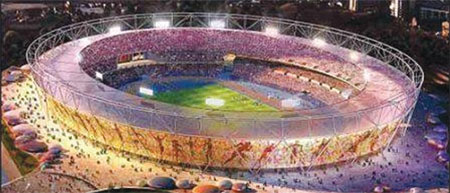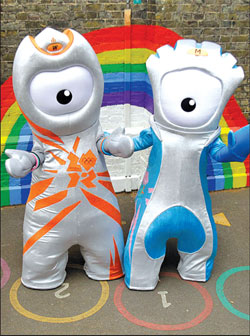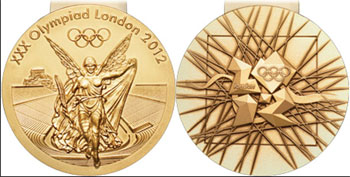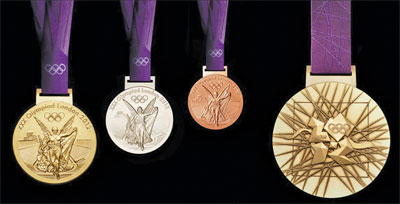|
London Olympics:
Let the Games begin...
Stadium will turn into a British meadow
The count down for the London Olympic Games has already begun. The
world is eagerly waiting for the Games to start because no matter where
the Games are held, the opening and closing ceremonies are generally
spectacular events not to be missed. What will the opening ceremony of
the 2012 Games be like? According to the artistic director of the Games,
Danny Boyle the Stadium will be transformed into a British meadow come
July 27.
 He
says the festivities will include fields, cows, ducks, horses and a game
of village cricket. The Olympic athletes will walk around the meadow,
made up of mini-fields separated by hedges and a river and the British
electronic group Underworld will provide music. At either end of the
stadium there will be "mosh pits" filled with standing members of the
public. One side will evoke the spirit of the Glastonbury music
festival, a huge pop extravagansa held on a dairy farm in southwest
England, while the other will reflect the Last Night of the Proms, an
annual classical music celebration. He
says the festivities will include fields, cows, ducks, horses and a game
of village cricket. The Olympic athletes will walk around the meadow,
made up of mini-fields separated by hedges and a river and the British
electronic group Underworld will provide music. At either end of the
stadium there will be "mosh pits" filled with standing members of the
public. One side will evoke the spirit of the Glastonbury music
festival, a huge pop extravagansa held on a dairy farm in southwest
England, while the other will reflect the Last Night of the Proms, an
annual classical music celebration.
Danny Boyle who won an Academy award as Best Director for his 2008
film, Slumdog Millionaire says he intends to make the ceremony titled
"Isles of Wonder, (inspired by William Shakespeare's play "The
Tempest,") a spectacle for the crowd in the Olympic Stadium as well as
for the huge international television audience around the world. The
four countries of the United Kingdom are represented with giant
representations of their emblem flowers - the rose for England, thistle
for Scotland, flax for Northern Ireland and daffodil for Wales. So, be
prepared to see something really out of the ordinary..
The opening ceremony is scheduled to start at 9 p.m. London time and
go for about three hours.However, Boyle admits it would be rather
difficult to keep the Games to time especially with a procession of
about 10,500 athletes from all over the world. The 42 million dollar
ceremony will also include 10,000 adult volunteers and 13,000 props.
Over a billion people are expected to throng the London Stadium.
The Olympic Stadium
The Olympic Stadium - the Games' crown-like main arena which will
seat 80,000 during the Games will scale down to a more manageable size
after the torch goes out.
The architectural firm Populous designed the stadium to transform
(via semi-deconstruction) into a building that will accommodate only
25,000. It may not look as visually striking or unique upon first glance
as some of the flashier Olympic stadia of decades past-such as the
eye-popping "Bird's Nest" of the 2008 Beijing Olympics but some of the
innovative ideas that Populous came up with to create a shrinkable
stadium will pay off in improved energy and material usage, when
compared to previous Olympic stadia. The core concept of creating a
large-scale arena that could easily become smaller led to money-saving
construction and operational solutions illustrates how one inventive,
focused design goal can often lead to others. While the Olympic Stadium
designed by Populous won't be a permanent landmark in its full form, the
creative ideas behind it will likely resonate and live on.
|

Wenlock, the Olympic mascot and Mandeville
(Blue), the Paralympic mascot. |
The Olympic Stadium with a 900-metre (1,000-yard) circumference is
located at Marshgate Lane in London's Stratford district in the Lower
Lea Valley and has capacity for the games of approximately 80,000 making
it temporarily the third-largest stadium in Britain behind Wembley
Stadium and Twickenham Stadium.
Land preparation for the stadium began in mid-2007, with the official
construction start date on May 22, 2008, although piling works for the
foundation unofficially began four weeks ahead of that date. The stadium
was chosen to host the 2017 World Championships in Athletics. The
stadium design was launched on November 7, 2007. As a unique 80,000-seat
stadium, it will be the centrepiece for the 2012 Games, hosting the
opening and closing ceremonies and the athletics events. It will be
downsized after the closing ceremonies and remain a permanent feature.
Olympic mascots
During the bid to host the Games, London promised to connect young
people with the power of the Games and in doing so inspire them to
choose sport. Wenlock and Mandeville, the London 2012 mascots, have
proved to be one of the most powerful ways to deliver this vision.
Wenlock is the official Olympic mascot and Mandeville is the official
Paralympic mascot for London 2012 Games .The mascots were designed by
London creative agency Iris.
They were created from 'two drops of steel from the Olympic
Stadium'.The name Wenlock is inspired by Much Wenlock, a small town in
Shropshire.In 1890, Baron Pierre de Coubertin was invited to visit Much
Wenlock by Dr William Penny Brookes, an advocate of physical education
in schools. De Coubertin watched Dr Brookes' 'Much Wenlock Games',
comprising athletics and traditional country sports with a procession of
flag bearers, competitors and officials.In 1894, de Coubertin's proposal
to establish the Olympic Games in a modern form was approved and the
very first modern Olympic Games were held in Athens two years later.
Mandeville's name is derived from Stoke Mandeville, in Buckinghamshire,
home to Stoke Mandeville Hospital.
Both Wenlock and Mandeville have a significant presence online, with
their own mascot website as well as individual Twitter and Facebook.
They are also a key part of London 2012's 'Get Set' education programme,
with pupils able to follow the mascots' progress as they learn about the
Olympic and Paralympic Values.London 2012 chairman Lord Coe said the
mascots had been created for children and he hoped they would inspire
young people to take up sport.
'By linking young people to the values of sport, Wenlock and
Mandeville will help inspire kids to strive to be the best they can be,'
he said.
Olympic medals

Some 4,700 gold, silver and bronze medals were made at the Royal
Mint's headquarters in Llantrisant, in Rhondda Cynon Taf for the Olympic
Games .The medals depict the Greek goddess of victory, Nike, stepping
out of the Parthenon and arriving in the host city.
The Royal Mint brought together a specially selected team of
designers, technicians and craftsmen who have been testing and refining
the minting process to ensure every medal produced meets highly exacting
specifications with each medal taking about 10 hours to make.
British artist David Watkins drew up the designs for the Olympic
medals, while those for the Paralympics were done by jewellery artist
Lin Cheung.
To replicate their designs, the medals are slowly rolled through a
750 degree furnace during a striking process which softens the metal,
allowing them to have the designs crafted.
The metal ore was used for the medals It was supplied by Rio Tinto
and is mined at Kennecott Utah copper mine near Salt Lake City in
America, as well as from the Oyu Tolgoi project in Mongolia. Adam
Lawrence, Royal Mint chief executive, said: "We are immensely proud and
honoured to be able to strike the Olympic and Paralympic medals.
"More than 800 local people are employed by the Royal Mint, and now
each one will be able to tell their children and grandchildren that
they, and south Wales, had a hand in creating a piece of Olympic
history."
Fact file...
Handover Ceremonies
A Handover Ceremony takes place during the Closing Ceremony at the
Olympic Games and Paralympic Games. The Handover normally lasts about
fifteen minutes. At the beginning of the Handover, the Olympic or
Paralympic Flag is taken down in the stadium and passed to the Mayor of
the next Host City. After that, the new Host City puts on a cultural
performance which is designed to show the world how exciting the next
Games will be.
The Opening and Closing Ceremonies
These Ceremonies traditionally mark the start and end of the Games.

There are separate events for the Olympic Games and Paralympic Games.
The Opening Ceremony follows an order of events involving the
entrance of the athletes, speeches, the raising of the flag, lighting of
the torch and then some world-class entertainment to celebrate the start
of the Games.
The Closing Ceremony also follows an order, where anthems are played,
the flag is passed to the Mayor of the next Host City and the flame is
put out.
Then the party begins - with athletes, spectators and officials
celebrating the end of a successful Games.
The Torch Relays
The Olympic Torch Relay and Paralympic Torch Relay signal the start
of each Games. The flame for the Olympic Torch Relay begins its journey
in Olympia, Greece.
Medal Ceremonies
The medal ceremony takes place soon after an event finishes. The
athletes who came first, second and third stand on a podium, with the
winner in the middle.
Their names are called out and the medals are given to them by an
official. The flags of the athletes' countries are raised and the
national anthem of the gold medallist's nation is played.
There is a gold, silver and bronze medal for each of the athletes.
The medals have to be at least 60mm in diameter and 3mm thick. The
medal designs are different for each Games.
The Olympic Tower
On June 15, the newly constructed ArcelorMittal Orbit was opened at
Olympic Park in London. Tagged to be a bold combination of steel, art
and sport. It came about as a result of the Mayor of London Boris
Johnsonís request to Britainís richest man , the steel magnate, Lakshmi
Niwas Mittal, chairman and chief executive of ArcelorMittal.
The Orbit, which was the result of that conversation, has opened to
mixed reactions. ArcelorMittal a big sponsor of the London Olympics,
covered 9.6 million pounds, or 30.8 million dollars, of the 22.7 million
pound cost of the Orbit. The Greater London Authority, the
administrative body that runs the city and is headed by the mayor, paid
the rest.
The curling steel structure is designed by Anish Kapoor, the Turner
prize-winning artist known for his large-scale installations.
At 114.5 metres, or 375 feet, the spiralling red structure is the
tallest sculpture in Britain and is about 22 metres taller than the
Statue of Liberty.
It can accommodate an estimated 5,000 visitors a day who can travel
to two platforms on two elevators. There they can spend 30 minutes
looking at a panoramic view of London, before descending 455 steps.
Kapoor said he wants visitors to the Orbit to experience the
sculpture not simply as a piece of art to be observed, but also from
within by winding up and down its steps. The Orbit is made from 2,000
tons of steel, 57 per cent of which is recycled.
It is ďa mythical tower of Babel that says Ďcome and join me,í Ē
Kapoor said. ďThe experience will be about winding up and in on oneself.
You want to forget the construction and engage with what youíre
experiencing.Ē At the top platform two large mirrors stretch around the
inside, designed to distort vision.
They reflect images of visitors that are larger and more imposing
than the buildings in the distance. And the view is like no other in
London, revealing a magnificent skyline as the sun begins to drop on the
hills.
On the descent, the Orbit comes to life. Itís a mass of twisted blood
vessels that glow and pulsate at night. The strips of steel seem like
glowsticks that have to be broken to be allowed to bleed and come alive
in the dark.
The Olympic Park
The Olympic Park in London, England, is situated to the east of the
city adjacent to the Stratford City development. It will contain the
athletesí Olympic Village and several of the sporting venues including
the Olympic Stadium and Aquatics Centre.
The ArcelorMittal Orbit, an observation tower and Britainís largest
piece of public art will overlook it. After the Olympics, the park will
be known as Queen Elizabeth Olympic Park, to commemorate the Diamond
Jubilee of Elizabeth II.
Some Olympic venues:
The venues and sports ...
*Aquatics Centre - Swimming, diving, synchronised swimming, modern
pentathlon (swimming) and water polo.
*Basketball Arena - Basketball, handball finals
*Eton Manor -- Aquatics training, wheelchair tennis
A new 130m-high wind turbine will also be located at Eton Manor. It
will help provide power to the park during and after the Games,
generating energy for the equivalent of 1,000 homes.
*Olympic Stadium - Athletics, opening and closing ceremonies.
*VeloPark -- Cycling Track, Cycling BMX
*Earls Court( West London) - Volleyball
From exhibitions and conferences to live music, Earls Court holds
hundreds of events each year attended by visitors from around the world.
*Greenwich Park on the south bank of the River Thames in south east
London. - Equestrian events
Greenwich Park - Includes the Old Royal Naval College and National
Maritime Museum, which, together with Greenwich Park, are part of a
World Heritage Site. It is Londonís oldest Royal Park, dating back to
1433. It has been a World Heritage Site since 1997. Within the park is
The Royal Observatory and the home of Greenwich Mean Time at Longitude
0degrees.
*Hyde Park in Londonís West End - Triathlon, 10k Open Water Swim
Hyde Park - The largest of Londonís Royal Parks, Hyde Park has been
open to the public since 1637.
The park is home to a number of grassroots sports clubs, including
the Serpentine Swimming Club, whose members swim in the Serpentine Lake
whatever the weather - even on Christmas Day.
*Lordís Cricket Ground - Archery
*Regents Park - Road cycling
Regents Park - One of Londonís famous Royal Parks, the Regentís Park
has been open to the public since 1845.
As well as being home to London Zoo and the Open Air Theatre, the
park is a much-loved sports venue for thousands of Londoners.
Facts and pix:
Internet |

